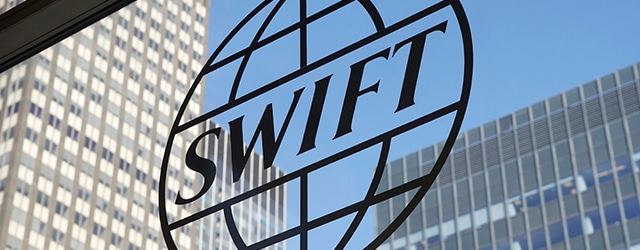The Belgium-based network must address fintech’s challenges to hold on to its dominant role in international finance.

Forty-six years ago, in a small municipality just over 9 miles from Brussels, a couple hundred banks decided to replace the telex with a faster and more secure network to make international transfers. They called it the Society for Worldwide Interbank Financial Telecommunications, or Swift, and today it connects 11,000 financial institutions. On average, the Swift system exchanges more than 33 million messages and processes upward of 24 million transactions each day.
Roughly half the network’s traffic consists of payments between financial institutions. However, Swift is much more than just a payments infrastructure. “It is the primary communications and messaging mechanism for a very large installed base of banks and institutions across different business areas,” says Anurag Bajaj, head of Transaction Banking Americas and global head of Correspondent Banking at Standard Chartered.
John Gubert, a former member of Swift’s Securities Committee and current chair of GTL Associates, estimates that 50% to 70% of Swift’s revenues come from fewer than 100 banks. “Big international banks put a lot of volume through Swift,” he says. “It has to keep them happy and secure.”
Being the most trusted communications provider to the world’s biggest banks doesn’t make Swift the most technologically advanced or the most cost efficient, however. “Why are the banks so loyal to Swift when there are cheaper alternatives?” Gubert asks. “It boils down to trust and competence. Swift’s technology might be slow; but from a bank’s perspective, what do you want: slow and very safe, or more speed and less safety?”
Such has been the calculus up to now. But is slow and safe going to cut it over the next 40 years, considering that Swift operates in an increasingly interconnected world with a growing number of alternatives? Arguably, the last few years have been some of the most challenging and transformative for Swift, as it responds to new competitors and a growing cybersecurity threat.
Tightening Security
Swift prides itself on the integrity and security of its network. But in 2015 and 2016, some member banks were hit by highly sophisticated, unprecedented cyberattacks via Swift—including the spectacular attempt to transfer $951 million held at the New York Federal Reserve Bank to accounts in the Philippines and Sri Lanka using Bangladesh Bank. Although some of the transactions were blocked and some money later recovered, $81 million slipped through.
 Samuel-Ogbu, Citi: Swift will clearly need to evolve its messaging infrastructure. |
Swift said the attacks did not compromise its network, but highlighted the need to tighten security controls at banks that connect to it. Under CEO Gottfried Leibbrandt, Swift instituted its Customer Security Programme, which shares cyberthreat intelligence and best practices for fraud prevention.
The measures Swift subsequently put in place extended the security perimeter beyond the physical network to the member banks, which should help prevent similar attacks in the future, says Jerry Norton, head of Strategy for consulting firm CGI’s UK financial services business.
“Swift has a proven record of security and resiliency,” says Simon McConnell, head of Global Clearing and Financial Institution Payments for Citi Treasury and Trade Solutions. Citi is one of Swift’s biggest users by volume. “Any new player to the market will have to prove they have the same degree of security and protection as Swift,” he says.
Others have their doubts. A hub-and-spoke model like Swift’s is especially vulnerable to cyberattacks compared to a “permissioned” blockchain or distributed ledger, says Peter Randall, president of financial blockchain provider SETL. “You’d need to change every record in the ledger at the same time in the same way.”
Competitors like SETL are finding other ways to disrupt Swift’s business. Technology providers like Ripple and TransferWise came to market promising to apply “smart, new technology” to cross-border payments, enabling the user to “skip using the old, rusty, slow Swift international transfer system,” as TransferWise states on its website.
Swift responded in late 2015 with its Global Payments Initiative (gpi), which updated the existing payment rails using application programming interfaces (APIs). “For Swift, the use of APIs is delivering the fast and transparent cross-border payments required by the industry,” says Stephen Lindsay, head of Standards. Some 50% of gpi payments are credited to accounts within 30 minutes and 40% in under five minutes, Swift says. More than 3,500 banks, which account for 85% of the network’s total payments traffic, reportedly have committed to adopting gpi, leading Leibbrandt to brand it “the biggest innovation in Swift’s 40-year history.”
Swift continues to explore distributed ledger technology (DLT) through a number of proofs of concept, Lindsay says, such as a new gateway to link trade and e-commerce platforms with gpi. This includes working with the blockchain consortium R3’s Corda to bring the benefits of gpi payments—speed, ubiquity and transparency—to DLT-enabled trade. But Swift still considers blockchain not ready for prime-time or “industrial usage.” “I don’t think Swift’s users would be keen for blockchain to become the replacement platform,” says Gubert. “Moving from a centralized platform like Swift and saying the blockchain is going to be as secure is a huge risk.”
Yet SETL’s Randall is convinced Swift will adopt blockchain eventually. “The trigger or thing that will allow it to happen is digital currencies being used for settlement finality in high-value payments between banks,” he says. “Watch this space.” That trigger event may be close, given Facebook’s announcement in June of a new payments infrastructure based on its own international stablecoin, Libra.
The Messaging Advantage
Fintechs have forced Swift’s hand when it comes to initiatives like gpi; it was a case of innovate or see nonbanks swallow up a lot of the network’s cross-border payments volume. What Swift has going for it, says Ireti Samuel-Ogbu, Citi Treasury and Trade Solutions’ head of Payments and Receivables for EMEA, is the 11,000 financial institutions already connected to it. “Any alternative needs to be able to scale quickly,” she says.
Swift FIN, the network’s core store-and-forward messaging service, is an advantage but needs to be updated to more enriched formats like ISO 20022 XML, which contains richer data for transmitting additional information with the payment, says Samuel-Ogbu. “All the payment systems, like CHIPS in the US and CHAPS in the UK, are moving toward ISO 20022. In some cases, they are using Swift, but there is an opening for competition,” she says. “Swift will clearly need to evolve its messaging infrastructure in a more interactive way to build messages that are more dynamic.”
Harry Newman, head of banking at Swift, says it aims to offer the right messaging solution, and results demonstrate success. “FIN messaging volumes have risen steadily over the past number of years,” he says. “Total FIN traffic rose to an all-time high of 7.8 billion messages in 2018.”
Initiatives like gpi and interactive messaging may buy time for Swift; but Randall argues that the cost of connecting to monolithic infrastructures like Swift is still high, which finance directors could find difficult to justify in the face of lower-cost alternatives. “The banks want the cheapest and most reliable way of delivering a transaction from A to B,” says Norton. “Swift has to ensure it adopts the right technologies in order to compete.”
Swift’s message prices are typically just a few cents per message, and “we’ve been able to reduce average costs significantly in recent years as we pass the benefits of increased volume back to the community,” says Thierry Chilosi, global head of Pricing.
The network is reasonably cost-competitive when it comes to pricing for medium-size and large institutions, says Standard Chartered’s Bajaj. But Swift needs to revisit its practice of rolling out new capabilities and services and pricing them on a per-bank identifier code (BIC) basis, which identifies a specific bank in an international transaction. This prevents smaller institutions from joining, due to high fixed costs.
Swift’s leadership also needs to look at ways of disrupting itself, Bajai adds; but that may prove difficult when the largest chunk of its revenues comes from traditional sources. “How does Swift ensure it retains the totality of the big banks? What happens if they start going to alternative providers?” says Gubert. “Banks could start fragmenting their payments traffic, putting some through Swift and some through a fintech, because of pricing.” With its collegial governance structure, he says, decision-making at Swift is slow for a world that’s changing very fast.
“They need to move in line with the market,” says Gubert. “In 20 years, Swift will still exist; but the risk is that it will be much smaller.”



